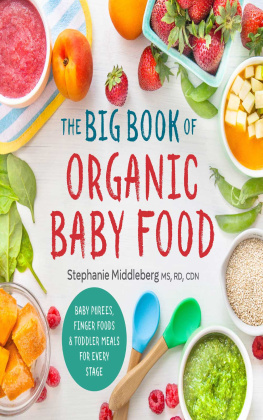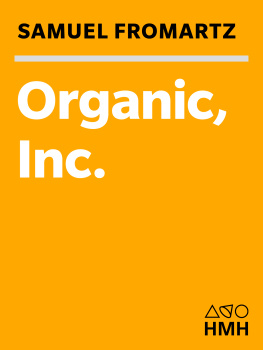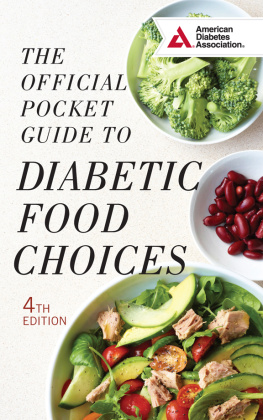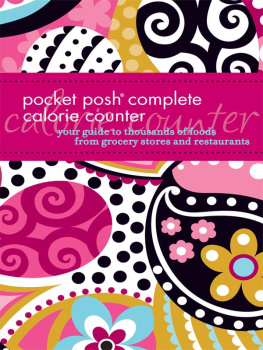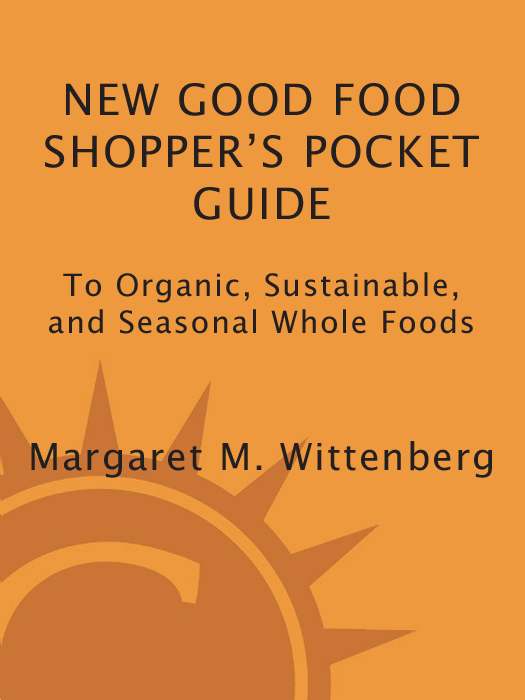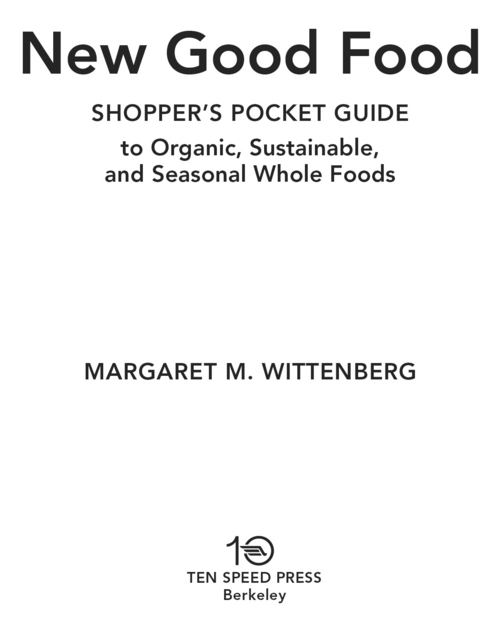Copyright 1997, 2008 by Margaret M. Wittenberg
All rights reserved. Published in the United States by
Ten Speed Press, an imprint of the Crown Publishing Group,
a division of Random House, Inc., New York.
www.crownpublishing.com
www.tenspeed.com
Ten Speed Press and the Ten Speed Press colophon are
registered trademarks of Random House, Inc.
Library of Congress Cataloging-in-Publication Data
Wittenberg, Margaret M.
New good food shoppers pocket guide / Margaret M. Wittenberg.
p. cm.
Summary: An updated pocket-size edition of the definitive guide to buying, storing, and preparing whole foods, featuring handy charts and tables that help shoppers navigate their many options when choosing organic, whole, local, and sustainably and ethically produced foodsProvided by publisher.
1. Food. 2. Nutrition. 3. Cookery. 4. Diet. I. Title.
TX354.W583 2008
641.3dc22
2008003683
eISBN: 978-0-307-76852-0
v3.1
Contents
Acknowledgments
Many, many thanks to all of you who have been a source of inspiration and support to me throughout my many years experiencing and learning the joys and wonders of good food.
Special fond regards go to the following wonderful people who have been particularly encouraging and supportive during the course of writing this book: my husband, Terry, for his unending love, patience, and passion for good food; my parents, Dolores and Merle Moothart, who have long instilled in me the appreciation of hard work, good judgment, and love of laughter; Ten Speed Press founder, Phil Wood, and publisher, Lorena Jones, for their much appreciated belief in my work; and my terrific editor, Melissa Moore, who has been a great partner and true joy to work with. Thanks also go to the entire editorial and design team at Ten Speed Press for their outstanding work, including my ace copy editor, Jasmine Star; editorial director Aaron Wehner; my initial editor, Amanda Berne; proofreader Jean Blomquist; designers Patrick Barber and Toni Tajima; and creative director Nancy Austin.
And, of course, I must acknowledge my dear cat, Junior, who has been a constant reminder that the best things in life are simpleplenty of good food, rest, and affection.
Introduction
Its no surprise that theres a resurgence of interest in eating good food. Eating the right type of foods for your own body can make a big positive difference in the way you feel throughout the day, including both during and after exercise. Not only that, the experience of how much more delicious foods truly are when made without unnecessary artificial additives has increased the demand for real food all the more.
This pocket guide is designed as a handy reference book to take along with you whenever and wherever you go grocery shopping. It provides at-a-glance information about what to look for when shopping for nutritious, great-tasting, high-quality foodsin short, good foods.
Youll find out what to look for when reading food labels, definitions of key words and terms commonly used on labels and signage, and how to buy in season. At home, it is an indispensable guide for what to actually do with the food: from how to cook a variety of products and at-a-glance information such as which foods are quickest to prepare to how to store foods for optimum nutrition and food safety.
For more detailed, unique descriptions about a wide variety of good foods from the common to the curious and information on what to do with them, insights on their origins, how they are grown or processed, sustainability considerations, their nutritional attributes and impact on health, and why foods react the way they do within the cooking process, be sure to pick up a copy of New Good Food: Essential Ingredients for Cooking and Eating Well, the definitive guide to exploring and enjoying good foods for todays shopper.
Words and Terms to Know
Enriched: Replaces five nutrients lost in grain processing: thiamin, riboflavin, niacin, folic acid, and iron.
Fortified: Food with nutrients added at levels higher than would be found in the original unprocessed food.
Fresh frozen: Food thats been quickly frozen while still fresh. Blanching before freezing is permitted.
Fresh: Food in a raw stateneither frozen nor subjected to any form of thermal processing or preservation. Exceptions include FDA-approved waxes on raw fruits and vegetables, pesticides applied before or after harvest, pasteurization of milk, produce treated with a mild chlorine or acid wash, and irradiation of raw foods not exceeding 1 kilogray (a unit of measure of radiation).
Genetically modified: The manipulation of an organisms genes by eliminating or rearranging specific genes or by introducing genetic elements from one or more other organisms, including across species boundaries.
Gluten-free: A food that neither contains nor is derived from wheat, barley, farro, grano, Kamut, rye, spelt, or triticale, and does not include 20 parts or more per million of gluten.
Imitation: A novel food that resembles and is used as a substitute for a traditional food. Foods must be labeled imitation if they contain less protein or a lesser amount of any essential vitamin or mineral than the traditional foods they replace.
Irradiation: A process in which food is exposed to gamma radiation from radioactive materials such as cobalt-60 or cesium-137, or through linear accelerator electron beams, to kill bacteria, insects, or parasites that may be present. However, even after irradiation, careful handling and proper storage and cooking of these foods is still necessary, despite all the marketing of irradiation as a food safety solution. Labeling of irradiated products is not required for all ingredients in a multi-ingredient product. The phrase treated with irradiation and the flowerlike irradiation logo have been required on single-ingredient foods for many years, although the term pasteurization might be allowed in some instances if other criteria for pasteurization are met. The FDA allows foods that have been irradiated at levels no higher than 1 kilogray (a unit of measurement for radiation) to be labeled as fresh.
Natural: Minimally processed, with no added colorings or artificial ingredients.
Organic: A labeling term that designates the food or product is certified to have been produced according to certain production and handling standards based on enhancing the health of the soil and harmony of the ecosystem. In the United States, a list of substances allowed or prohibited in organic farming, production, and processing is maintained as part of the national organic standards. Processed products labeled Made with Organic Ingredients must contain at least 70% organic ingredients and list up to three of the organic ingredients on the principal labeling panel.
Quickly frozen: Food frozen using a system such as blast freezing, allowing it to quickly freeze to the center of the food with virtually no deterioration.
Trans fats: A type of fatty acid formed when liquid oils are processed into more solid fats, like partially hydrogenated fats, vegetable shortening, and hard margarine, creating a molecular structure that seldom occurs in natural fats. Trans fats have been linked to a long list of health problems, including obesity, infertility, increased risk of cancer and heart disease, and accelerated aging and degenerative changes in tissues. Trans fats are typically found in vegetable shortening, some margarines, and crackers, cookies, snack foods, and other foods made with or fried in partially hydrogenated oils.


